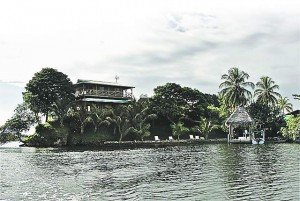
(Des Moines Register) During our stay in Costa Rica in February, my husband and I decided the neighborly thing to do was to visit Panama. After a bit of research, we chose two towns: Bocas del Toro on the Caribbean side and Panama City on the Pacific side. Two coasts, two extremes.
Bocas del Toro is a typical tropical Caribbean town, except that most of the hotels and restaurants are located on nine scattered islands created centuries ago from a serendipitous volcano explosion. (The locals may have seen it differently at the time.) We took a water taxi to the Garden of Eden Resort — not so much a hotel as a large tree house. With only three rooms, the owners (Harley Davidson fanatics transplanted from Florida) insist we don’t need to lock — or even shut — our doors at night. But we do because of the snakes that slither in the jungle just beyond our balcony.
The shower water comes from a barrel of collected rain on our rooftop, but apparently heating it is an extravagance. Sleep comes easy, but morning is announced by the birds, specifically, the pet chickens and a talkative toucan.
After breakfast by the pool, we took a water taxi to a “cocao” plantation run by American ex-pats. The owners walked us around their 10-acre plantation nestled in a rain forest. They explained the tedious but very worthwhile process of making chocolate, and capped it off with an eagerly-awaited tasting at the end. It is dark even at noon under towering trees and vines, a perfect environment for spiders, monkeys, frogs and their 4,000 cacao trees.
The following day we arranged a flight across the country. We might as well have flown into New York City! A million people, a thousand skyscrapers and terrible traffic; it’s as different from Bocas as East is from West.
After a long, hot shower, we dined at La Posta, an elegant and true Panamanian experience, replete with slow-turning ceiling fans and a dozen varieties of rum.
On the fourth day, we visited the Panama Canal, which, we were told, brings in $6 million every day for Panama. It is an engineering marvel, but we find it a bit anti-climatic because the process of sending ships through the locks takes several hours. (Ancient mariners roll their eyes at our impatience.)
Nonetheless, we happily check it off our list of must-see spots in the world.
When it’s time for dinner, we head to Panama Viejo (Old Panama), the original capital of the country, with buildings dating back to the 1500s. A major restoration project is underway here, and again the dichotomy between the old and the new is shocking.
We are given careful instructions by our cab driver about the “safe” streets, but without a doubt, this is our favorite part of the country. Restaurants, bars and shops abound and entice. Every meal we eat in Panama City is delicious.
Panama is not for the faint of heart, but adventurous adults and teens will be amazed.